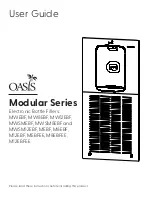
Publication: MAN3002G
MAC Equipment, Inc.
5
and straight as possible, avoiding bends. Such ducts must
be capable of withstanding a pressure at least as high as
that expected to develop inside the filter itself in the event
of an explosion. Ducts increase internal pressures inside
the filter, and special reinforcement of the filter may be
required. Consult MAC Equipment, Inc. Engineering
Department regarding your specific application.
Any duct will decrease the effectiveness of the vent.
Explosion Vents-General
Explosion vents are available from MAC Equipment Inc., in domed
rupture panel styles as part of the filter system. The rupture panel style
functions by bursting the panel itself. Explosion vents are installed after
the filter unit is assembled on its support structure.
Installing Domed Rupture Panel Style Vents
The installation of the rupture panel style vent should be performed by
two people.
Refer to Figure 4-3 below.
Figure 4-3 Typical Rupture Style Explosion Vent
1.
Remove the hold-down frame from the vent mount on the side of the
filter.
2.
Carefully remove the rupture style vent panel from the crate
(CAUTION! Edges of the vent panel are sharp!) Avoid excessive
flexure of the vent.
3.
Place the vent panel over the protruding bolts in the housing wall.
The vent panel must be oriented correctly. The panel ruptures on
three sides and hinges on the fourth. The hinge side is indicated by
a v-notch in the edge. Place the panel with the v-notch to the left
and the I.D. tag at the bottom as shown in Figure 4-3. The dome
must protrude outward as shown or the panel will not function.
4.
Place the hold down frame over the bolts, making sure that an even
pressure is brought to bear on the panel.
5.
Tighten nuts evenly and use an alternating pattern to prevent
damage to the vent panel. Tighten nuts to 20-25 ft. lbs. of torque. It
is not necessary to use an excessive amount of pressure to clamp
the panel securely.
Ductwork and Accessories
CLEAN AIR
DUCT
TIMER
CONTROL
AIRLOCK OR
OTHER OUTPUT
ACCESSORY
RADIAL INLET
PNEUMATIC
RECEIVER
INLET
Figure 4-4 Location of Ductwork and Accessories
1.
Connect the inlet duct to the radial or pneumatic receiver inlet on the
filter.
2.
Connect the clean air duct to the exhaust located at the top of the
filter housing. Ductwork must be constructed to withstand the
system design pressure. The ductwork must be independently
supported; the AVR filter is not designed to support ductwork.
3.
Attach any auxiliary equipment (such as an airlock or screw
conveyor) to the discharge flange of the hopper.
Electrical Controls and Wiring
The filter is supplied with NEMA 4 electrical solenoids and timer control.
A NEMA 7 or 9 option is available. The timer is protected by a board
mounted fuse. Refer to the label on the timer control for power
requirements.
Timer Control Logic
Input power is applied to the timer control at all times that the AVR filter is
in operation.
“
Continuous
”
cleaning occurs if the
“
Pressure Switch
”
contacts on the
timer board are jumpered; if so, cleaning will occur whenever the system
is energized, and is controlled by an electronic timer.
When energized, the timer begins the
“
time
-off
”
part of its cycle. At the
end of the
“
off
”
period, the control energizes solenoid Number 1 to
provide a timed cleaning pulse to the first row of bags. At the end of the
pulse the
“
time
-off
”
period begins again; when it ends the c
ontrol
energizes solenoid Number 2. The control cycles through each of the
solenoids in turn, providing a cleaning pulse to each row of filter bags.
The process continues as long as the system is energized. The durations
of the cleaning pulse (
“
time
-on
”
)
and
“
time
-off
”
are both adjustable. A
program wire allows for field selection of the number of solenoids.
For
“
on demand
”
cleaning, the pressure switch contacts are wired to a
remote photohelic switch/gauge or other pressure sensing device.
Cleaning occurs as above as long as the remote contacts on the
switch/gauge are closed. When they open the cleaning operation stops.
When the contacts close again the control remembers the last solenoid
activated and resumes the cleaning cycle with the next one in line.
Excessive tightening may damage fasteners
or the explosion vent panel.
Only trained and authorized persons should be
permitted to service or maintain electrical
components. It is the buyer
’
s/installer
’
s
responsibility to ensure that all applicable
electrical codes are met.
Summary of Contents for AVR
Page 2: ......
Page 15: ...Publication MAN3002G MAC Equipment Inc 12 ...
Page 16: ...Publication MAN3002G MAC Equipment Inc 13 ...
Page 17: ...Publication MAN3002G MAC Equipment Inc 14 ...
Page 18: ...Publication MAN3002G MAC Equipment Inc 15 ...
Page 19: ...Publication MAN3002G MAC Equipment Inc 16 ...
Page 20: ...Publication MAN3002G MAC Equipment Inc 17 ...
Page 24: ......
Page 25: ......









































